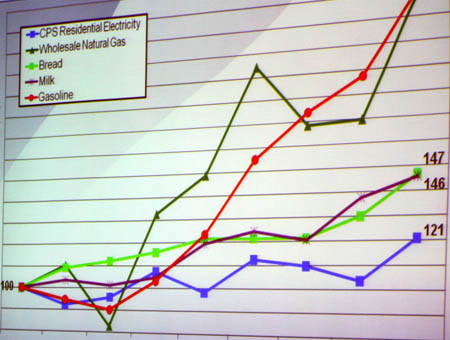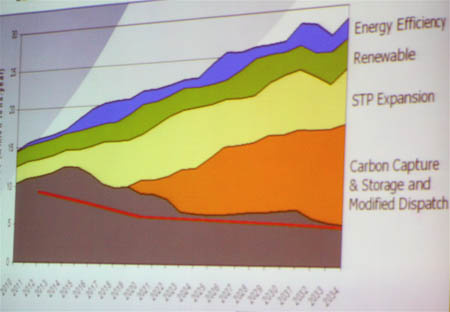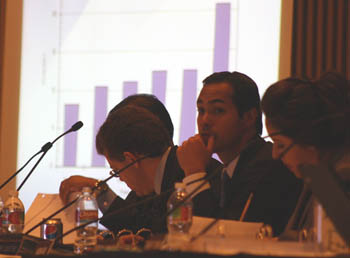CPS $13 billion nuke figure spins against renewables
June 30, 2009
By Greg Harman
San Antonio Current
queblog

CPS chart explaining why nukes are better than bread and milk.
It would have been alarming had CPS Energy's figures not gelled with their nuke partner (soon to be absorbed by hostile nuke polluter Exelon?) NRG Energy.
The pair are hoping to double the size of their jointly held South Texas Project nuclear complex outside Bay City.
While anti-nuke activists and skeptics have suggested the final pricetag could reach as high as $22 billion, NRG said two nukes for $10 bil, no problem
.
San Antonio-owned CPS Energy told their board yesterday that $10 billion is indeed the magic number, but that with needed financing the number would rise to $13 billion.
Our share (if the two utilities are able to drop their now 50 percent shares to 40 percent and bring in a third partner, as they hope to) would be $5.2 billion. What a deal, right? Still, it's more than $2 billion more than the current value of the utility.
Activists at Sustainable Energy and Economic Development stuck by their guns, suggesting the price should be "double what they're telling the public."
"The money could go four times further with energy efficiency and renewable while building the San Antonio economy," said SEED director Karen Hadden. "Sinking money into Japan and Bay City doesn't help the people of San Antonio."
By now, you've heard most of this. The press corps was at full attention, trotting out the key numbers along with the arguments of the battlebotin' pros and cons.
 What we can't help marvel over was the failure of CPS's leadership (by that we mean the reanimated Milton Lee, saved from an early retirement to help close the nuke deal, and his sidekick, acting GM Steve Bartley of the whipsaw handshake and casual dress ambitions) to project continued declines in the cost of renewables.
What we can't help marvel over was the failure of CPS's leadership (by that we mean the reanimated Milton Lee, saved from an early retirement to help close the nuke deal, and his sidekick, acting GM Steve Bartley of the whipsaw handshake and casual dress ambitions) to project continued declines in the cost of renewables.
While I'd been informed by a well-positioned CPSer that the just-signed solar thermal contract will cost CPS 17-cents per kilowatt hour, the Lee-Bartley presentation projected anticipated costs for solar thermal ranging from 17 cents up to 24 cents per kilowatt. And yet solar costs have been declining for years.
Another bizarro-world assumption by the power duo has to do with greenhouse gases.
According to the Powerpoint (above), half of the CO2 reductions the utility would need to make under terms of the federal climate bill being debated in Congress would be reached thanks to Carbon Capture & Storage, technology that still under development and Bartley himself told the board held "the biggest question mark."
That's 13 million tons of climate-disrupting greenhouse gases released by 2034 being wagered on a "question mark."
"Even with all of these tools, we still fall short of the goals authored under Waxman-Markey,"Bartley said.
So, does maintaining the cheapest electricity in the state outweigh avoiding catastrophic climate change as a corporate value? Why, yes it do, amigo(a)s.
But power is needed. According to CPS, San Antonio's power needs will surpass our available power supply by 2020. And whatever the path forward, rates will increase.
However, according to figures presented to the board, while new nukes would require rate hikes every other year through 2018, they would start saving CPS customers afterwards, up to an estimated $20 on an average utility bill in 2034.
While rates in SA, as compared to cities like Houston and Corpus Christi, languishing in deregulated Texas and nearly twice our power prices, were used to promote CPS's good works, some would have liked to see what decentralized renewables would look like by the utility's (or maybe others') calculations.
 New CPS board member mayor Julián Castro rubbed his eyes repeatedly toward the end of the spiel, saying yesterday afternoon's gathering was the third time he'd seen CPS's Powerpoint.
New CPS board member mayor Julián Castro rubbed his eyes repeatedly toward the end of the spiel, saying yesterday afternoon's gathering was the third time he'd seen CPS's Powerpoint.
That didn't keep him from asking questions. Questions, we suspect were as aimed at public relations as much as the bulk of the Powerpoint itself, tailored as it is toward the sure-to-be-grueling public debates to come rather than to the already-briefed board members.
Castro asked what would prevent this proposed expansion of two Advanced Boiling Water reactors from going over budget, as the first two nukes at the South Texas Project nuclear complex did.
Bartley also said the deal would be protected by the currently deflated dollar, the amount of engineering work already performed, and the fact the site was originally built with expansion in mind.
Bartley added that, as a majority owner in the expansion, he also expected the utility would benefit from fixed-cost pricing.
Mike Phillips, a leader in San Antonio-based COPS/Metro Alliance community action group, said he left the hearing with even more questions.
"What we're saying is, the meter's running. With a $2 billion investment before a fixed-price contract, it seems more like a forgone conclusion that they'll be going ahead with the project."
While much of the energy generated by the two-plant expansion will be sold into the ERCOT power market, board member Aurora Geis also said the CPS board were going to be debating and discussing how much emphasis CPS should place on selling wholesale power into the market.
"We're continuing to have dialogue about [that],"Geis said. "We need to very clearly have our policy statement in place and we recognize that. Though no decision is being made today, we are very conscientious that we will need to address that."
Concluded Barley: "We intend to take the next 90 to 100 days to go out and engage with the community ... Mayor we will meet with each council member ... We will go out to homeowner association meetings. We will have breakfast meetings, lunch meetings. We will go out every night if need be to talk not only about our recommendation but about the many options that we looked at .. Hopefully we will have a very fruitful summer."
Geis, the force that pushed Lee and others to tour solar developments in Spain and helped bring renewable-energy visionary Jeremy Rifkin to San Antonio, hoisted Mayor Catro's cell phone toward the end of the meeting, saying, "The mayor has a digital device here... that has quickly evolved in our market in less than probably 18 months. The analogy is that as we look at the positions the board is taking toward a distributed model, the technologies will become so evident that the projections we're putting in place today will be so different tomorrow.
"We have a tremendous amount of questions and discovery that we're still in the process we're engaging in."
Be that as it may, Bartley said CPS leaders will approach the City Council in October to discuss means of financing the nuke expansion.
Fair Use Notice.










